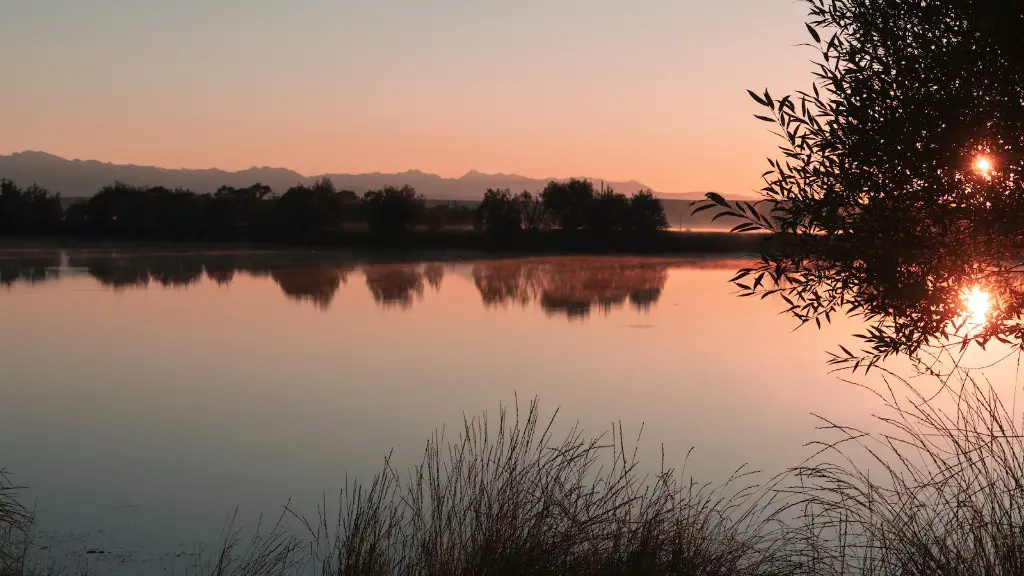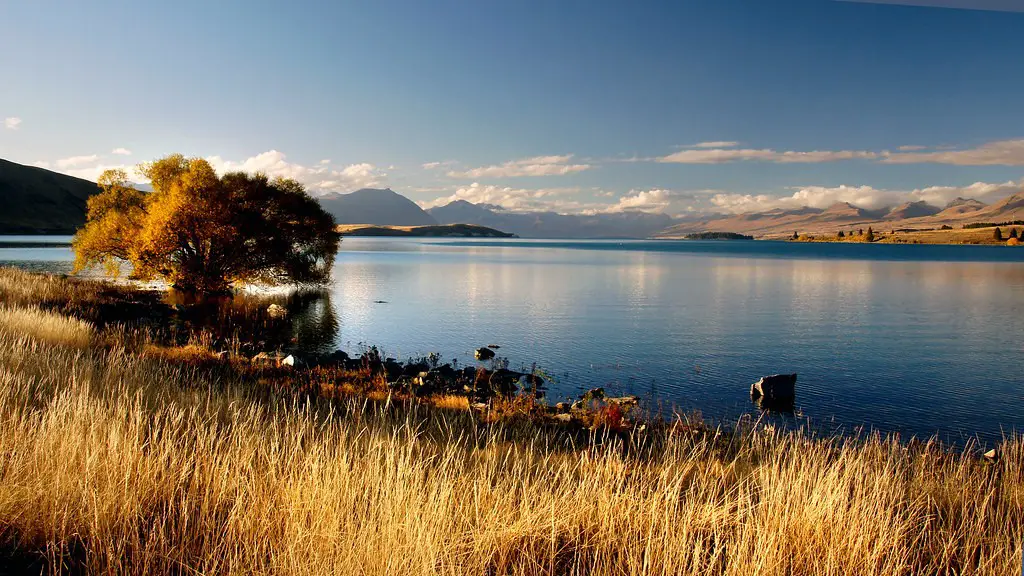Introduction
Lake Titicaca is one of the most attractive and captivating bodies of water in the world. It is the largest lake in South America and has a rich historical and cultural significance. Located in the high Andes of Peru, it is a popular tourist destination and has long been a source of spiritual and cultural enrichment for the locals. This article will explore the size and significance of Lake Titicaca as well as provide more in-depth information about its unique character.
The Physical Characteristics of Lake Titicaca
At 8,500 square kilometers (3,231 square miles), Lake Titicaca is the largest high altitude lake in the world. Its surface elevation is 3,813 meters (12,500 feet), making it the highest navigable lake in the world. Lake Titicaca is the fifth largest lake in the world, located in the Andes Mountains in South America. It is large and is broken up into two different basins divided by a small strait of land. The northern basin is larger and deeper at 28.5 meters (93 feet) while the southern basin is shallower at 13 meters (43 feet). The lake is fed by several rivers including Ramis, Ilave, and Suchez.
Lake Titicaca also has several islets and islands, many of which have cultural or spiritual significance. Taquile, Amantani, and Uros are three of the most popular islands of the lake, each with different histories and attractions. Lake Titicaca is a great place to discover and explore.
Peruvian Heritage and Cultural Significance
Lake Titicaca is a source of major cultural significance for Peru. The lake is surrounded by numerous archaeological sites and it has served as an important source of food and resources for many communities living around it. In addition to this, it has served as an inspiration for many creations and beliefs in Peru.
The Incas believed that their god, Viracocha, emerged from the center of Lake Titicaca. Many of the remaining ruins in the region, including the famous Inca ruins of Sillustani, are dedicated to Viracocha. The islands of Taquile, Uros, and Isla del Sol are all considered sacred sites and continue to be important places of cultural exchange and pilgrimage. The surrounding environment also continues to inspire an array of traditional culture-art, music and theatre.
The Benefits of Visiting Lake Titicaca
Visiting Lake Titicaca can be both a rewarding and life-changing experience. It’s a place to explore, gain insights into the history and culture of Peru, and explore the surrounding environment.
Visiting Lake Titicaca allows you to explore the archaeological sites around the lake. You can also spend time on the lake in a traditional boat and explore the unique islands. Visiting the lake also provides an opportunity to learn about the local culture and history, as well as the traditional boat-building techniques still practiced by many communities in the area.
Finally, for those interested in the spiritual aspect of the lake, Lake Titicaca is a good place to visit to gain insights into the ancient beliefs and spiritual practices of the Incas.
Threats to Lake Titicaca
Despite the cultural and spiritual significance of Lake Titicaca, the lake is facing numerous challenges such as pollution and diminishing water levels. The introduction of invasive species, such as trout and carp, have upset the fragile balance of the lake and caused the virtual extinction of a few fish species that were native to the lake. In addition, the transformation of surrounding wetlands into agricultural lands has significantly reduced the quality of the lake water.
In recent years, there have been attempts to reduce the effects of pollution and to protect the lake’s biodiversity. These efforts have been somewhat successful but much more needs to be done to protect and restore the lake’s ecosystem.
Sustainability On Lake Titicaca
Due to the unsustainable development practices around Lake Titicaca, there is an increasing need for sustainable practices in order to preserve this unique and beautiful environment. A number of initiatives, from local communities to international organizations, are working to promote and increase sustainability in the region.
One such organization is the Global Nature Fund (GNF), which is working to promote sustainable practices in the Lake Titicaca region. The GNF is supporting local communities and working with them to develop sustainable fisheries, better manage waste, and increase the conservation of local biodiversity.
In addition, a number of private initiatives have cropped up in recent years, such as eco-tourism, to promote sustainability in the lake. Eco-tourism resorts and companies have sprouted up in the region and have made great strides in promoting sustainable practices in the region.
Lake Titicaca and Climate Change
Climate change is one of the most pressing issues affecting Lake Titicaca. Studies have shown that the lake’s water level has been decreasing due to global warming. As temperatures rise and glaciers continue to melt, the amount of water entering the lake is rapidly diminishing. This has a direct effect on the region’s biodiversity and the quality of the lake water.
In addition to this, climate change is also affecting the livelihood of the people living around the lake. The people dependent on the lake’s resources – fishing, aquatic plants, and other forms of subsistence – are facing an uncertain future as the lake’s resources dwindle. As a result, an increasing number of people have been leaving the region in search of better opportunities elsewhere.
Optimism for the Future of Lake Titicaca
Despite the myriad of challenges that Lake Titicaca is facing, there are still reasons for optimism. Over the past few decades, there has been an increased awareness and understanding of the lake and the environment around it. Local communities and activists are actively working to protect the lake’s resources and biodiversity and to promote sustainable practices.
In addition, modern technologies and processes are being implemented to help improve the water quality as well as to reduce the impacts of climate change. For example, the use of floating wetland habitats is becoming increasingly popular to reduce the impacts of pollution from surrounding communities.
The future of Lake Titicaca is uncertain, but with the right policies and initiatives, it is possible that the lake can be fully restored and preserved for future generations.
Oil Spills and its Effect on the Lake
Recently, oil spills have become increasingly common in Lake Titicaca. The spills occur as a result of oil extraction activities that take place in the area. The spills have caused significant damage to the lake’s biodiversity as well as to the local economies that depend on the lake’s resources.
The effects of the oil spills can be devastating. Not only do they pollute the water and harm the aquatic life, but they also cause contamination of the soil and air, which has an immediate effect on the communities and ecosystems around the lake. In addition, the oil spills can cause long-term damage to the lake’s water quality and ecology.
Solutions to Oil Spills
Given the serious threats posed by oil spills in Lake Titicaca, solutions must be developed to address this issue. One solution is to invest in improved oil spill prevention technology. The use of preventive measures such as safe and secure containment systems can help to reduce the risk of future spills.
In addition, improved communication and collaboration between local stakeholders and oil companies is essential. This can help to create a shared understanding of the risks associated with oil extraction in the region and to develop solutions to address them.
Finally, a better understanding of the risks associated with oil spills is also necessary. Further research and studies on the impacts of oil spills in the region are needed to better understand the effects of oil spills and to develop effective solutions.
Efforts to Restore Lake Titicaca’s Natural Beauty
Given the many threats to Lake Titicaca, numerous efforts have been made to restore and conserve the lake’s natural beauty. Recent initiatives include the creation of nature reserves to protect the lake’s biodiversity and to promote conservation.
In addition, local communities have set up sustainable tourism initiatives to promote the lake’s natural beauty and to raise awareness about its importance. Through education, research, and advocacy, these activities are helping to raise awareness about the unique character of the lake and its importance to the region’s economy.
Conclusion
Lake Titicaca is a unique and captivating lake with rich and diverse cultural significance, located in Peru. It’s one of the largest and highest altitude lakes in the world, and its many islands provide a great opportunity to explore the lake and its history. However, the lake is facing numerous challenges such as pollution and diminishing water levels, and it is essential that effective solutions are developed to ensure the protection and restoration of the lake’s ecosystem.



